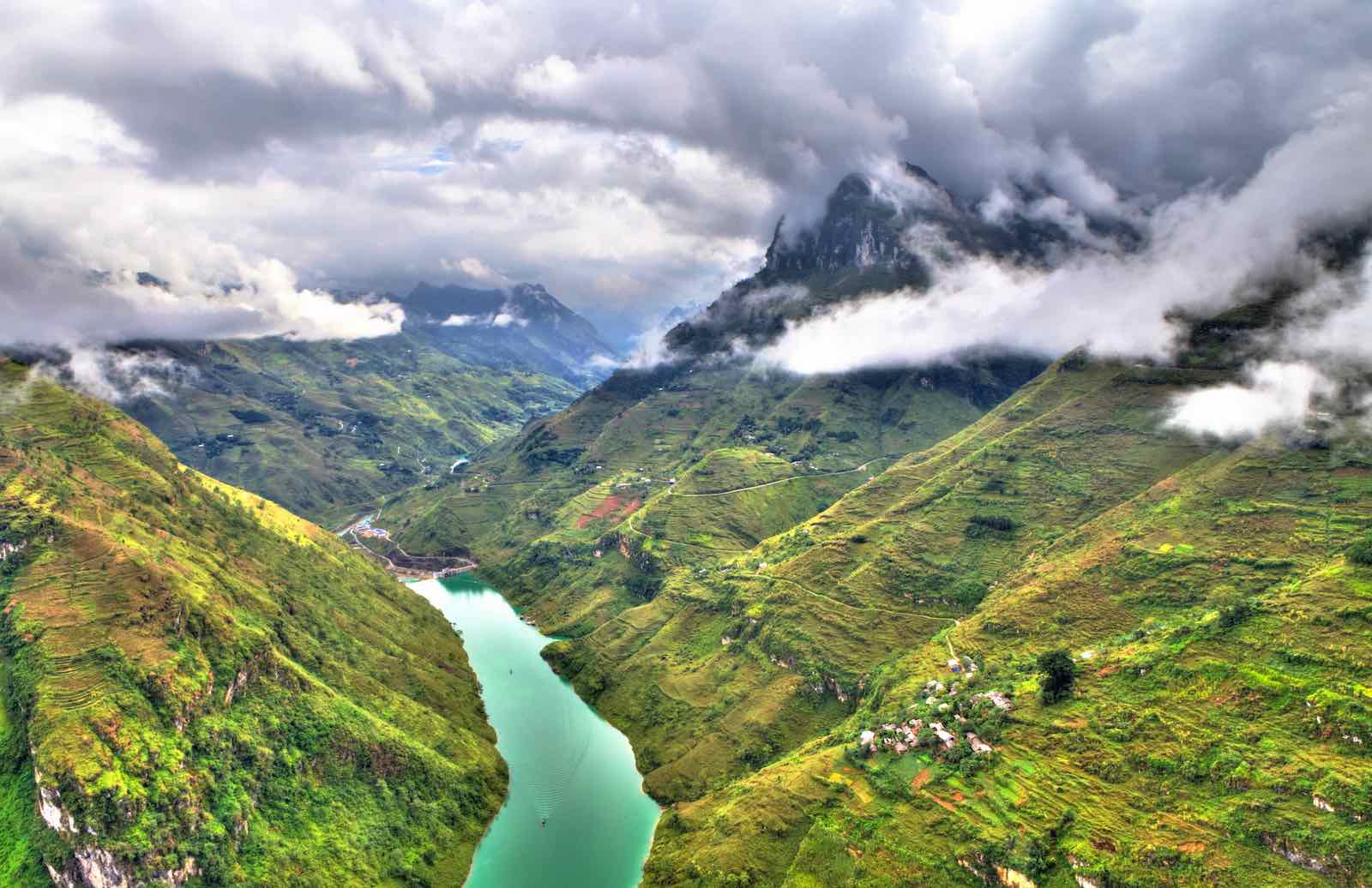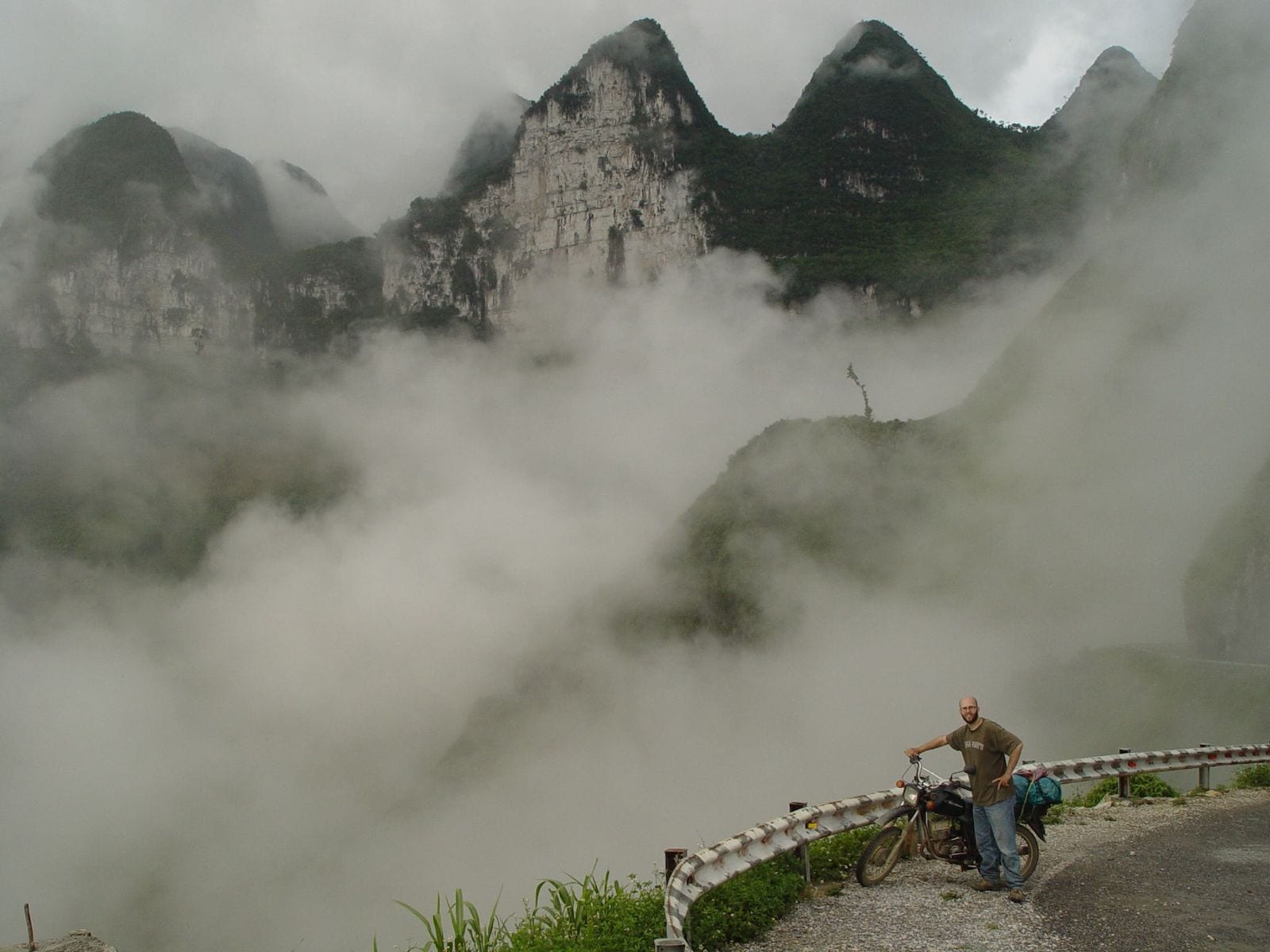Far from the crowds of Hanoi, tucked into a mountainside in Vietnam’s Northern frontier, there’s a little-known paradise for any road-trip junkie.
One of the region’s “Four Great Passes,” and arguably the most spectacular, the Ma Pi Leng Pass is a place of extremes… Gorges plunge away from the roadside, jagged mountaintops skim the clouds, and the locals’ rugged culture is a distant relation to frantic city life.
North Vietnam’s Skyline Highway

Buried deep in the beautiful Dong Van Karst UNESCO Geopark, the Pass connects the mountainside towns of Dong Van and Meo Vac.
It leads you on a winding journey through some of Vietnam’s highest mountains, including Ma Pi Leng Peak (2000m). The landscape is inhospitable, but on every new hillside, your eye can pick out a scattering of huts and farms cut vertically into the slopes, balancing on stilts and prayers.
As you travel deeper into the scenery, the Pass feels increasingly tiny in the vast landscape. It clings to cliff edges and mountainsides with an impossible grip, offering a perfect vantage point for numerous breathtaking views across the valleys and ridges.
And the views are breathtaking. The highest peaks, thick with jungle, jut out like green icebergs above the clouds. On the plateaus, Vietnam’s distinctive, tower-like hill formations rise abruptly out of the valley floor, forming the silhouettes of sailboats at sea. And, far below the road, at the foot of the deepest canyon in South East Asia, flows the bright turquoise ribbon of the Nho Que River.
But, despite their seclusion, the locals will always give you a warm welcome. Children often stop for a curious but friendly stare—the braver ones giving a wave or a quick “hello.” Deciding to stop for a chat in improvised sign language can quickly have you surrounded by half a dozen or more curious, chattering faces!
Geography, History & Culture

The Ma Pi Leng Pass lies within the greater Dong Van Karst Plateau. On Vietnam’s Northernmost frontiers, before the Chinese border. It’s characterized by its impressive limestone mountains, lush vegetation, and diverse cultures.
Beginning in 1960, the construction of the Pass was notoriously dangerous. Due to the unforgiving landscape and the absence of any modern equipment, it took two years to complete and cost numerous workers’ lives.
With seventeen different ethnic minorities living in the Plateau, it’s a vibrant melting pot of traditional Vietnamese cultures. Unlike in the more developed regions, each group still holds on to its own language, customs, and subculture.
In the local towns, Sundays are market days. If you get the chance, it’s well worth taking the morning off to browse the stalls and get a flavor of local life. And, if you happen to be in Ha Giang in April, be sure to check out the Khau Vai Love Market. It displays local music, traditional food and drink, arts, and clothing; A fascinating insight into the local culture.
When to visit

If possible, plan your trip between October and November or between March and April.
- The dry season runs roughly between October and April. The rainy season is from May to September, with the highest rain during June and July.
- The dry seasons are cooler, while the rainy seasons are hotter and more humid.
- The coldest months are from December to February, with a minimum temperature of 48°F (9°C). It’s hottest from July to September, with a maximum temperature of 84°F (29°C).
Visiting during the dry season will give you the best mountain views and the safest road conditions. However, between December and February can be uncomfortably cold. Particularly if you’re on a motorcycle!
Traveling during the rainy season carries much higher risks. Slippery road conditions only increase the hazards on steep mountainside passes, with landslides being relatively common.
Transport: Your Options
So, what’s the best way to see the Ma Pi Leng Pass?! You have three choices:
1) Motorcycle/Motorbike
The adventurist’s choice! If you’re confident to swing a leg over a bike, then these mountains will become your playground! This is one of the most popular ways to see the area and gives you the freedom to travel at your own pace. The roads, although not always perfectly paved, are a joy to ride. It’s a twisty, tricky route but one that is immensely rewarding!
A word of warning: This isn’t the place to learn how to ride. The same factors that make the roads an enjoyable challenge to an experienced rider will make them a hazard to a newbie. The pavement can be incredibly steep, narrow, and unevenly surfaced. This, in combination with oncoming traffic and cliff edges, leaves very little margin for error!
Renting
There are motorcycle rental shops in Hanoi, Ha Giang, and Dong Van. Instead of heading into whichever is closest, it’s certainly worth taking the time to research a reputable vendor online first. Prices start from around $10 per day, and $20 per day should get you a comfortable machine with plenty of power for the hills.
Motorcycle alternative
Motorbike taxi, known as “xe om:” The South-East Asian Uber!
You can pick one up in any of the towns and negotiate a price for a day trip along the Pass. It’s an excellent option for anyone who isn’t confident about driving themselves but who loves the feeling of the wind in their hair! Just remember that xe om drivers aren’t professional tour guides. They won’t give you information on points of interest, and they drive in the local style!

Another motorcycle alternative
Ha Giang Loop tour package: This is a popular three or four-day route that includes the Ma Pi Leng Pass and other local landmarks. If you don’t mind spending a little extra, a tour company will arrange the whole trip for you, leaving you to relax on the bike and take in the scenery!
You can choose to be either a passenger or a driver, and prices start from around $210 per person and include transfer from Hanoi.
2) Car
The second most popular choice. If a motorbike isn’t your style, then you can travel by car. Much like the motorbike options, you can choose to rent a taxi independently and organize the trip yourself. Or, you can book through a tour operator for around $250 per person.
3) Bus
It’s possible, but it isn’t recommended! Buses run from Ha Giang to Dong Van and Meo Vac, but they are not tour buses. They don’t stop at any viewpoints, and the ride is often bumpy and uncomfortable.
Getting to the Pass from Hanoi
Although the Ma Pi Leng Pass is the highlight, people rarely travel 300km from Hanoi just for the 20km Pass. It makes more sense to incorporate it into a more extended sightseeing trip, like the Ha Giang Loop.
Whether you’re doing a longer tour or not, a trip to the Pass is likely to start from Ha Giang town.
By motorcycle: To reach Ha Giang from Hanoi, allow around seven to ten hours. That sounds like a long time for 300km, but the progress on Vietnamese roads can be slow!
Bus: Buses run regularly from Hanoi to Ha Giang. You’ll then need to take another bus to Dong Van, where you can pick up a car or bike for the Pass. Alternatively, you can switch to a car or bike here at one of Ha Giang’s tour or rental companies. Changing to your preferred mode of transport sooner, rather than later, will make for a much more enjoyable onward journey.
The scenery is undoubtedly spectacular enough to be worth enjoying!
The route
After the long journey from Hanoi, you’ll definitely want to stop in Ha Giang! It’s five hours to the next stop, so trying to complete it in one day wouldn’t be any fun!
Following a good night’s rest, take the left side of the Loop up towards Dong Van. Dong Van is a small town, but there is no shortage of places to stay, and you will be well catered for.

The next day, you can set off for Meo Vac at a leisurely pace. There are plenty of places for photo opportunities along the way; Ma Pi Leng Viewpoint is deservedly the most famous.
A top tip is to download an offline maps app and mark the viewpoint, along with any other points of interest. Once you’re on the road, it is easy to feel lost without it!
There is no need to take a packed lunch. There are several coffee shops and restaurants along the roadside, so you’ll never be short of a drink and a bite to eat.
Final thoughts
This stunning road deserves to be on any Asian adventurer’s list of paths to travel!
Still relatively undiscovered, the Ma Pi Leng Pass is a rich reward for anyone who makes the long journey from the tourist traps. If you’re seeking a real sense of what Vietnam is and who the Vietnamese people are, it’s one of the very best short adventures you could ever do.


 Mūi Cà Mau National Park – Cau Ma Province
Mūi Cà Mau National Park – Cau Ma Province